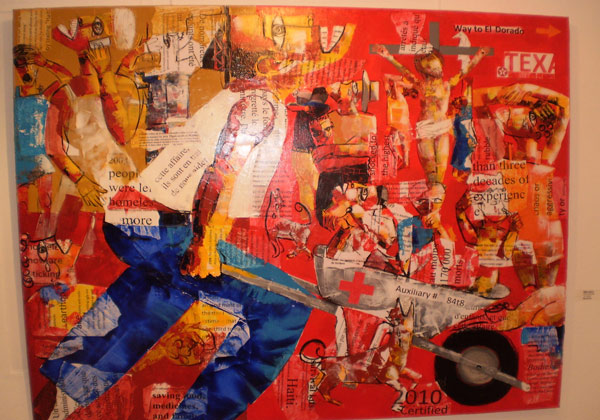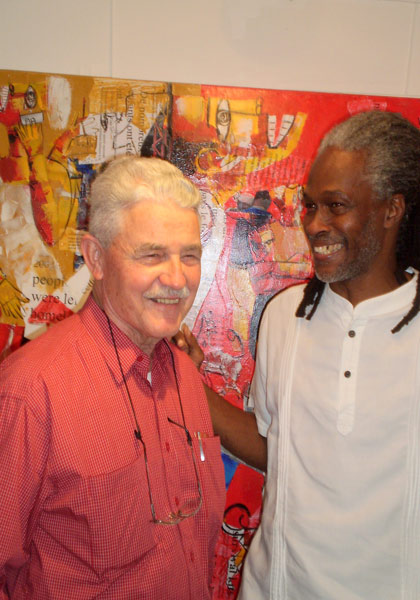 Great Bay:---The earthquake that has claimed some 200,000 lives in Haiti and left that Caribbean nation in ruins has evoked quite some artistic response as the whole world rushes in with an avalanche of humanitarian aid. But few artists have captured on canvas, the depth and spiritual dimension of this incredible tragedy as Mosera has done in "After Shock", an imposing painting that grabs the viewers' attention for its size as much as for its thematic content and treatment.
Great Bay:---The earthquake that has claimed some 200,000 lives in Haiti and left that Caribbean nation in ruins has evoked quite some artistic response as the whole world rushes in with an avalanche of humanitarian aid. But few artists have captured on canvas, the depth and spiritual dimension of this incredible tragedy as Mosera has done in "After Shock", an imposing painting that grabs the viewers' attention for its size as much as for its thematic content and treatment.
Like a mural, "After Shock" dominates the walls of Tropisme Gallery in Grand Case, where Mosera is showing some of his latest works alongside a curious set of African masks from the private collection of entrepreneur and connoisseur, J.C. Huet, who came from Paris precisely to participate in this exhibition titled, "Linkage".
The masks, generally from East Africa (although a few originate from West Africa), are displayed almost as ornaments, and remain unobtrusive, although their spirit seems to permeate the paintings, imbuing them with a mysterious and ominous air. It is as if they were placed as iconic reminders of Mosera's artistic roots.
Red is the dominant color in the about a dozen paintings in this exhibition. Perhaps, appropriately so. In this "Red Period", Mosera employs this primary color as a backdrop that allows his main subjects to stand out in sharp relief. It is also used as a symbol of passion, tragedy, and even of a fiery sunset by the Lagoon. For Mosera, red is the color of quiet but tortuous contemplation, as in "Contemplator" or even in "Femme sous Grenadiers". It is the color of inspiration as in "Muse" and to a lesser extent, in "Violin Player". Red is also the color of a peaceful sip of black coffee, as in "Coffee". All these acrylic paintings, however, combine the three primary colors – red, yellow and blue - in varying degrees, to offer a complete and very striking palette that is as attractive as it is defining.
Nowhere is this combination of primary colors more shockingly effective than in "After Shock", Mosera's soulful depiction of the horrors of the earthquake that turned Port-au-Prince into a massive graveyard. Hell could not be more bloody red.
It was Pablo Picasso who once said, "There are painters who transform the sun into a yellow spot, but there are others who with the help of their art and their intelligence transform a yellow spot into the sun."
In "After Shock," Mosera has transformed the grief, the pain and sorrow, the harrowing, nightmarish Armageddon of Haiti's apocalyptic earthquake, into a statement of solidarity and universal empathy just as Picasso himself transformed the ugliness and barbaric carnage of the Spanish Civil War into Guernica, his most celebrated anti-war painting.
Almost every face in "After Shock" is turned skywards, as if asking the heavens "why?" It is a question that the whole world is still pondering as the survivors are caught in that region between life and death where suffering stifles hope, where each breath is an unsure step out of the clutches of the grave into the stench of survival. "Why?" "Why, Lord?" The survivors cry, mouth agape, tears and sweat dried up on their mask-like, awe-stricken faces. At one end of the canvas, a man seems to be holding his private part with one hand, as if to reassure himself that he has not been castrated, while with the other he clutches a cellular phone to his ear, screaming into it for help or simply informing some distant relative that he's alive?
At one end of the canvas, a man seems to be holding his private part with one hand, as if to reassure himself that he has not been castrated, while with the other he clutches a cellular phone to his ear, screaming into it for help or simply informing some distant relative that he's alive?
At the other end, is the figure of Christ nailed to the cross, with the text "Way to El Dorado" floating nearby, while we read the incomplete name of "Texas" with the logo of oil giant, Shell, affixed in the lower left-hand corner of this signboard. This should not be seen as a fortuitous, disjointed reference in view of reports of the alleged involvement of big oil in causing the earthquake. As wild and "off the hook" as such allegations might sound, the magnitude of the tragedy goes beyond human comprehension, thus requiring that our imagination be stretched beyond all known limits.
The main figure in "After Shock" is a tall, sinewy, man, pushing a wheel-barrow as ambulance full of injured, dying and dead victims of the earthquake, the only siren being his anguished wailing and the unrestrained howling of tearful dogs. Interspersed with newspaper clippings in both English and French, apparently to draw us into attempting to decipher the text, the full impact of the painting is however gleaned from a distance. Mosera succeeds in turning Haiti's tragedy into a personal experience for the viewer, as he tries to make sense out of a senseless, helpless, and hopeless descent into a monumental abyss. We are all in this together; we have all become Haitians in what seems to be end-time.
The other paintings in the exhibition are thematically different, each one bearing the unmistakable imprint of Mosera, an artist who is forcing us to see beyond our mundane existence and interpret reality from a more spirit-filled perspective.
The exhibition is open daily from 10:00AM to 1:00PM and from 5:00PM until 9:00PM and continues until February 21, 2010. It is a must see for all lovers of good art.












